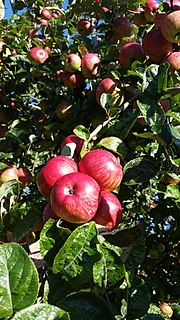| 'Michelin' | |
|---|---|
| Species | Malus domestica |
| Origin | |
Michelin is a variety of cider apple commonly grown in commercial orchards in the United Kingdom, although originating in France.
| 'Michelin' | |
|---|---|
| Species | Malus domestica |
| Origin | |
Michelin is a variety of cider apple commonly grown in commercial orchards in the United Kingdom, although originating in France.
'Michelin' was raised by the nurseryman Legrand of Yvetot, Normandy, and first fruited in 1872. [1] It was named for the pomologist Henri Michelin who carried out a great deal of study into cider fruits. [2] It was first brought to England in 1883 or 1884 by members of the Woolhope Naturalists Club of Hereford, who visited a Rouen horticultural show with the aim of proving a link between the so-called "Norman" cider apple varieties of Herefordshire and genuine Normandy cultivars. Although they were unable to find any similar varieties, they did bring back several apples including 'Michelin' and 'Medaille d'Or'.
'Michelin' proved to be an extremely heavy cropping and reliable cider apple. Although rare in France, by the 20th century it had become the most planted cider variety in England, especially in conjunction with 'Dabinett' (notably in orchards planted for the Taunton Cider Company). [3]
'Michelin' is a mid-season, medium 'bittersweet' apple, [2] relatively high in sugars, low in malic acid, and high in tannins. Its avoidance of biennial fruiting tendencies makes it a reliable cropper, though its juice makes a relatively characterless cider unless blended with other varieties.
Its medium-small sized, green apples bear a close resemblance to the variety 'Brown Snout' without the latter's characteristic patch of russetting.

Calvados often nicknamed Calva, is an apple or pear brandy from Normandy in France.
Perry is an alcoholic beverage made from fermented pears, similar to the way cider is made from apples. It has been common for centuries in England, particularly in the Three Counties ; it is also made in parts of South Wales and France, especially Normandy and Anjou. It is also made in Commonwealth countries such as Canada, Australia and New Zealand.
Cider apples are a group of apple cultivars grown for their use in the production of cider. Cider apples are distinguished from "cookers" and "eaters", or dessert apples, by their bitterness or dryness of flavour, qualities which make the fruit unpalatable but can be useful in cidermaking. Some apples are considered to occupy more than one category.

Tardebigge is a village in Worcestershire, England.

The Kingston Black, also known as Black Taunton, is a cultivar of apple originating from the United Kingdom and used in making cider. The name of the cultivar comes from the apples' dark red or purplish skin, though despite the name, the fruit does not have a black hue.

Cider is an alcoholic beverage made from the fermented juice of apples. Cider is widely available in the United Kingdom and the Republic of Ireland. The UK has the world's highest per capita consumption, as well as its largest cider-producing companies. Ciders from the South West of England are generally stronger. Cider is also popular in many Commonwealth countries, such as India, Canada, Australia, and New Zealand. As well as the UK and its former colonies, cider is popular in Portugal, France, northern Italy, and northern Spain. Central Europe also has its own types of cider with Rhineland-Palatinate and Hesse producing a particularly tart version known as Apfelwein. In the U.S., varieties of fermented cider are often called hard cider to distinguish alcoholic cider from non-alcoholic apple cider or "sweet cider", also made from apples. In Canada, cider cannot contain less than 2.5% or over 13% absolute alcohol by volume.
'Brown Snout' is a 19th-century cultivar of cider apple originating in Herefordshire in the United Kingdom, though now grown in other counties and parts of the world.

The Foxwhelp is a very old cider apple cultivar, originating in the west Midlands of England.

The Redstreak, also spelt Redstrake, Red Streak or Red-streak, is or was a very old variety of cider apple formerly commonly planted in England.
The Hangdown, also known as Hangydown, Horner, or the Pocket Apple, is a traditional variety of cider apple grown mostly in Somerset and North Devon.

'Tom Putt' is a traditional variety of dual purpose apple, often used as a cider apple, originating in Devon. It was also known as Ploughman, Coalbrook, Marrowbone, Thomas Jeffreys and by many other local names.

Slack-ma-Girdle is an old variety of cider apple formerly widely grown in the South-West of England. It is one of a group of similar and closely related varieties all often known by the name "Woodbine".
Crimson King, also known as John Toucher's or the Bewley Down Pippin, is a traditional cider apple cultivar originating in Somerset.

The Woodcock was one of the oldest described English varieties of cider apple. It originated in the West of England in the counties of Herefordshire and Gloucestershire.
Ellis Bitter, also called Ellis's Bitter or Ellis's Bitter-Sweet, is an English cider apple originating in Devon, but now widely planted across the west of England.
The 'Chisel Jersey' is a cultivar of cider apple originating in Somerset.
The Coccagee, also spelt 'Cackagee' or 'Cockagee' and sometimes known as the 'Irish Crab' or 'Lord Cork's Crab', is or was a variety of cider apple, known in Ireland and the West of England.
Yarlington Mill is a traditional cider apple cultivar originating from the village of Yarlington, in the North Cadbury area of Somerset, England.
Major is a cider apple cultivar first grown in the United Kingdom in the area of Devon and Somerset.
Cap of Liberty, also known by the name Red Soldiers or Bloody Soldier, is a traditional cider apple cultivar originating in the Martock area of central Somerset.